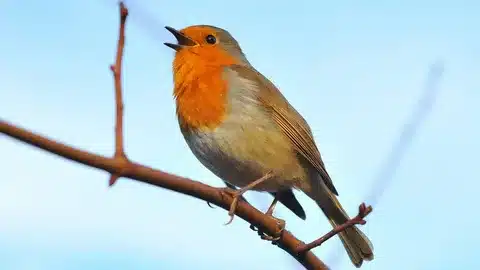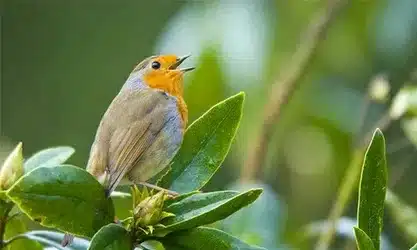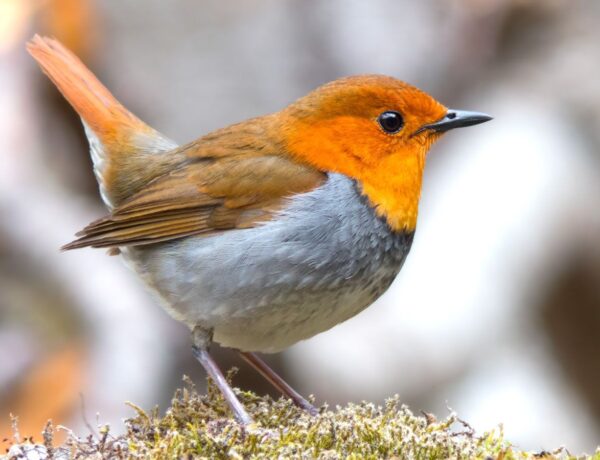Introduction
What Bird Looks Like A Robin: The robin, with its striking red breast and sweet melodious song, is a well-known and beloved bird in many parts of the world. However, there are several other bird species that bear a resemblance to robins in various ways, from their appearance to their behaviors. These birds, often referred to as “robin-like” species, can sometimes be confused with true robins, leading to interesting bird watching experiences.
In this exploration, we will delve into the fascinating world of birds that resemble robins, discussing their physical features, habitats, and behaviors. While these birds may share some similarities with robins, they often have distinct characteristics that set them apart, making them intriguing subjects for bird enthusiasts.
From the American Robin, commonly found in North America, to other global counterparts like the European Robin, we will uncover the diversity of species that capture the essence of the robin’s charm. Join us on this journey to discover and appreciate the avian counterparts that resemble the beloved robin.

What bird is mistaken for a robin?
Both the spotted and eastern towhee are birds that look like robins, with some key differences. If you’re able to get a good look at the bird’s eyes, check whether they’re red. Red eyes are a distinctive feature of towhees that robins don’t have. If not, check for the birds’ white breast and dark-colored upperparts.
Birdwatchers and nature enthusiasts often encounter cases of mistaken identity when it comes to birds. In the context of robins, one bird species that is commonly confused with them is the Eastern Bluebird. Here’s a closer look at this case of mistaken identity:
Eastern Bluebird Resemblance: Eastern Bluebirds, with their bright blue plumage, have a somewhat similar size and shape to robins. Their reddish-brown chests can be reminiscent of a robin’s red breast, leading to occasional mix-ups.
Distinguishing Features: While Eastern Bluebirds share some similarities with robins, they have distinct characteristics. Bluebirds have striking blue feathers on their heads, wings, and tails, setting them apart from robins. Robins, on the other hand, are primarily brownish-gray with a bright red or orange chest.
Vocal Cues: One of the most reliable ways to distinguish these birds is through their songs. Robins have a melodious, flute-like song, while Eastern Bluebirds have a softer, warbling call.
Habitats and Behavior: Eastern Bluebirds often prefer open fields and nest in cavities, while robins are more adaptable and can be found in various habitats, including woodlands and urban areas.
Range: Geographic range also plays a role in distinguishing the two species. Eastern Bluebirds are typically found in eastern North America, while robins have a more extensive range across North America.
What is the big bird that looks like a robin?
A member of the family Icteridae, Bullock’s oriole bird looks like robins but is bigger. They are active and often seen hanging upside down or stretching to reach their prey. The male species have a black body, white wing patch, and black line over their orange eyes.
When it comes to birds resembling robins, the American Robin (Turdus migratorius) takes center stage. Despite its name, the American Robin is a distinctly North American bird that shares some characteristics with its European counterpart. Here’s an in-depth look at the American Robin and its resemblance to the robin:
Physical Resemblance: The American Robin shares a similar body shape with the European Robin. It features a plump body, a long, slender bill, and a distinctive reddish-orange breast.
Size and Coloration: American Robins are larger than European Robins, with a length of about 10 inches (25 cm). Their plumage varies from grayish-brown on the upperparts to a vibrant orange-red on the breast.
Behavior and Habitats: American Robins are known for their adaptability and can be found in a range of habitats, from woodlands and gardens to urban areas. They are also known for their melodious, flute-like songs.
Range: American Robins are native to North America, and their range extends from Alaska to Mexico. They are a common sight throughout the continent.
What looks like a robin but has a white belly?
While their rufous sides are similar to the robin’s belly, they don’t extend all the way across. So their white belly is a good clue to tell them apart, as well as their red eyes, black beak and the fact that the black on their head extends down onto the chest.
When searching for a bird that resembles a robin but features a striking white belly, the Varied Thrush (Ixoreus naevius) stands out as a prominent candidate. This bird, native to North America’s western regions, exhibits notable similarities to robins while sporting a distinctive white underbelly. Here’s an in-depth exploration of the Varied Thrush and its unique features:
Physical Resemblance: Varied Thrushes share a robust, robin-like physique with a plump body and long legs. Their overall coloration closely resembles that of a robin, including shades of gray and brown on their upperparts.
White Belly: One of the key distinctions between Varied Thrushes and robins is the striking white belly found on Varied Thrushes. This stark contrast in coloration sets them apart.
Range: Varied Thrushes are primarily found in western North America, particularly in coniferous woodlands and mountainous regions. Their range extends from Alaska down to northern California.
Vocalizations: These birds are known for their haunting, flute-like calls, which differ from the melodious songs of robins.
Seasonal Migrations: Some Varied Thrush populations migrate southward during the winter months, making them occasional visitors to regions where they are not typically found.
Is an oriole a robin?
Similar Species to Baltimore Oriole, All About Birds, Cornell …
Some people occasionally mistake American Robins for Baltimore Orioles, but robins are thrushes with shorter bills, rounder heads, solid-brown backs, and a more subdued shade of orange on the breast.
Orioles (family Icteridae) and robins (family Turdidae) are two distinct bird families, each with its own unique characteristics. They share little in common beyond being songbirds and inhabiting North America. Here’s a closer look at these two bird families:
Taxonomy: Orioles belong to the family Icteridae, while robins are part of the family Turdidae. These are different taxonomic families with distinct traits.
Physical Characteristics: Orioles are often smaller and more slender than robins. They typically have bright, striking plumage with hues of orange, yellow, and black, while robins are known for their brownish-gray upperparts and orange-red breasts.
Range and Habitat: Orioles are commonly found in woodlands, forests, and suburban areas, with some species migrating to North America during the summer. Robins, on the other hand, are more widely distributed across North America, including urban areas, and are known for their adaptability.
Nesting and Behavior: Orioles are known for their intricate hanging nests, often woven from plant fibers. Robins construct open cup-shaped nests, typically situated in trees or shrubs.
Vocalizations: Orioles have distinct songs, often characterized by melodious whistles and trills. Robins, on the other hand, are recognized for their rich, flute-like songs.
What is a white robin called?
Some have a white instead of gray back, and a few are pure white! These are called albino robins.
Robins are typically known for their distinctive brownish-gray upperparts and vibrant orange-red breasts. However, on rare occasions, individuals with a different plumage coloration are observed, often described as “white robins.” These unique robins are not a separate species but rather a result of leucism, a genetic condition affecting pigmentation. Here’s a closer look at these uncommon “white robins”:
Leucism Explained: Leucism is a condition characterized by the partial loss of pigmentation in an animal’s feathers, skin, or scales. It can result in white or pale-colored patches.
Appearance: “White robins” exhibit white or pale feathers in areas where typical robins would display brown or reddish hues. However, they may retain some coloration in their eyes and beaks.
Rarity: Leucistic robins are exceptionally rare, making sightings of these birds an exciting and unusual experience for birdwatchers.
Health and Survival: While leucistic robins may face challenges due to their unusual appearance, they are capable of surviving in the wild and living a relatively normal life.
What does a lady robin look like?
Males and females look identical, sporting a brown back, white belly and red breast, face and cheeks. In contrast, juveniles are speckled gold and brown, only developing the distinctive red plumage in adulthood.
Female robins, often referred to as “lady robins,” possess distinctive features that set them apart from their male counterparts. While they share some similarities, there are notable differences in their appearance and behavior. Here’s a closer look at what a lady robin looks like:
Size and Shape: Female robins have a similar size and shape to male robins, with a plump body, long legs, and a slender bill. They both exhibit the characteristic robin profile.
Plumage: Female robins typically have plumage that is slightly duller and less vibrant than that of males. Their upperparts are brownish-gray, and their breasts are a paler shade of orange or red.
Eye Ring: One distinctive feature of female robins is the presence of a prominent white eye ring, encircling their eyes. This feature is less pronounced or absent in males.
Behavior: During the breeding season, female robins are responsible for building the nest and incubating the eggs. They are diligent parents, ensuring the well-being of their offspring.
Song: Female robins do sing, but their songs are typically softer and less elaborate than the melodious tunes of male robins.
Can robin birds fly?
Robins can fly for many hours each day, so on days with good migrating conditions, they probably cover roughly 100-200 miles per day.
Yes, robins are indeed proficient fliers. These birds are known for their ability to fly gracefully, and their flight plays a crucial role in their daily activities and survival. Here’s a closer look at the flying capabilities of robins:
Adapted for Flight: Robins possess the anatomical adaptations necessary for flight. Their bodies are streamlined, with strong muscles that power their wing movements.
Agile and Manoeuvrable: Robins are agile in flight, capable of making quick turns and maneuvers. This agility is useful when foraging for insects or avoiding predators.
Migratory Flights: Many robins undertake long-distance migrations, flying thousands of miles between their breeding and wintering grounds. These migratory flights are impressive feats of endurance.
Daily Activities: Robins use flight for daily activities such as commuting between feeding and nesting sites, searching for food, and evading potential threats.
Territorial Behavior: During the breeding season, male robins often engage in territorial flights to protect their nesting territories and attract mates.
What is a black robin called?
The black robin or Chatham Island robin (Moriori: karure, Māori: kakaruia; Petroica traversi) is an endangered bird from the Chatham Islands off the east coast of New Zealand. It is closely related to the South Island robin (P. australis).
The black robin, scientifically known as the Chatham Island robin (Petroica traversi), is a rare and critically endangered bird species native to the Chatham Islands of New Zealand. This captivating bird has earned its colloquial name due to its distinctive plumage and striking appearance. Here’s an exploration of the black robin:
Plumage: The black robin is named for its predominantly black plumage, which contrasts sharply with its bright white abdomen and undertail coverts. This coloration is especially striking in males.
Conservation Status: The black robin was once on the brink of extinction, with only five known individuals in the 1970s. Thanks to intensive conservation efforts, their population has increased, although they remain critically endangered.
Habitat: These robins are endemic to the Chatham Islands, an isolated archipelago that provides their natural habitat. They inhabit a range of forested and shrubby environments.
Behavior: Black robins are known for their curious and endearing behavior. They are known to hop in a distinctive sideways manner, which is both charming and distinctive.
Conservation Success: The story of the black robin’s recovery from near extinction is celebrated as a success in wildlife conservation, showcasing the power of dedicated efforts to save endangered species.

Conclusion
In the world of birds, there are several species that share striking resemblances with the iconic robin. From their reddish plumage to their cheerful songs, these robin-like birds add diversity and intrigue to the avian landscape. While some may bear a physical resemblance, others may exhibit similar behaviors or occupy similar habitats.
The American Robin, a symbol of spring in North America, remains a cherished favorite with its vivid red breast. Meanwhile, the European Robin, with its charming red throat, has captured the hearts of birdwatchers across the Atlantic.
The exploration of these robin-like species offers a deeper understanding of the diversity of birdlife and the various adaptations that have evolved across different regions of the world. Birdwatching enthusiasts and nature lovers can appreciate the beauty of these birds, whether they’re observing true robins or their avian counterparts.





No Comments